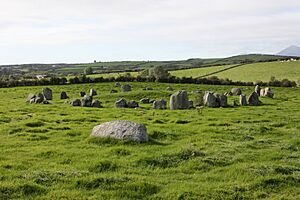Ballynoe Stone Circle facts for kids
The Ballynoe Stone Circle is an amazing ancient stone circle. It is found in a small village called Ballynoe. This village is about 4 kilometers (2.5 miles) south of Downpatrick, in County Down, Northern Ireland. You can find it near an old, unused railway station. To get there, you walk along a long path from the main road. The circle is very large and impressive. It sits in a flat, rich farming area, not far from the sea. This makes it a special place in the middle of the fertile Lecale peninsula.
Contents
What is the Ballynoe Stone Circle?
This site is very large and has many parts. It looks like a big circle made of over 50 stones standing upright. Many of these stones are placed very close together. Some stones are as tall as 1.8 meters (six feet)! The circle surrounds an open space about 33.5 meters (110 feet) wide.
Stones and Markings
Some of the stones that have fallen have small holes or hollows. These might be "cup-marks," which are small, round carvings made by people long ago. Most of the stones in the outer circle are made of a local rock called Silurian grit. But a few are made of granite. These granite stones are called erratics. This means they were carried here by glaciers from somewhere else.
There are also some stones outside the main circle. Two stones stand about 2.1 meters (7 feet) apart just outside the circle on the west side. There are also four other stones further away. Two are to the north-east, and two are to the south-west.
The Mound Inside the Circle
Inside the eastern part of the circle, there is an oval-shaped mound. This mound is surrounded by a border of stones called a kerb. It measures about 14 meters (46 feet) by 17.6 meters (58 feet). The longest part of the mound runs from east to west.
Right inside the circle on the west side, there is an arc of six stones. These stones support the edge of a raised platform. This platform is in a similar spot to the oval mound on the east.
What Was Found?
When archaeologists dug here, they found that the mound was about 1.5 meters (5 feet) high. It was made of stony earth, with a pile of stones (a cairn) in its center. Under the mound, between the cairn and the stone border, they found smooth, rounded boulders. These are sometimes called "baetyls."
They also found large stone boxes called cists at both the east and west ends of the mound. Inside these cists were cremated bones. This means human remains that had been burned.
How Old is It?
It seems that the Ballynoe Stone Circle was built over a long time. It might have started as a long stone structure, like a court tomb. Then, a round mound with a stone border, similar to a passage tomb, was added to the east end. Finally, the stone circle was built around all of these structures.
This suggests the site was used and changed over many years. It probably dates from the late Neolithic period (New Stone Age) to the early Bronze Age. This makes it a very old and important place! Some experts, like Aubrey Burl, have noticed that Ballynoe has features similar to stone circles found in Cumbria, England.
Who Explored It?
The mound at Ballynoe was dug up and studied in 1937 and 1938. A Dutch archaeologist named Dr. AE Van Giffen led this work. Sadly, he passed away before he could publish all his findings about the site.
What the Dig Found
The excavation mainly focused on the mound. They found stone cists (boxes) that held cremated bones. The only pottery found was a small piece from outside the mound. It was a decorated rim piece from Carrowkeel ware, which is a type of pottery from passage graves.
There were also many small pockets of cremated bones scattered between the mound and the stone circle. The archaeologists learned a lot, but they couldn't fully explain how all the different parts of the site were connected.
Gallery









